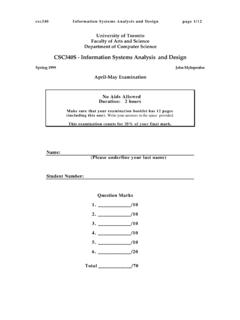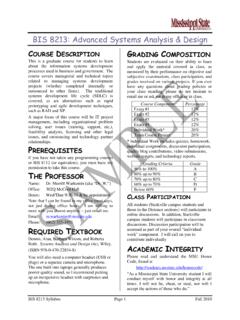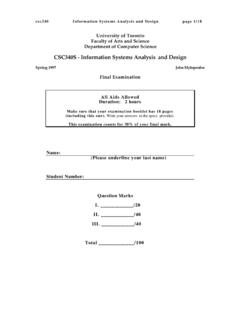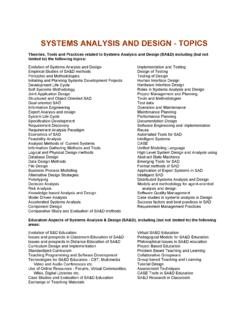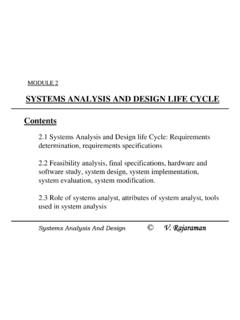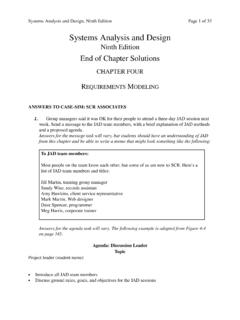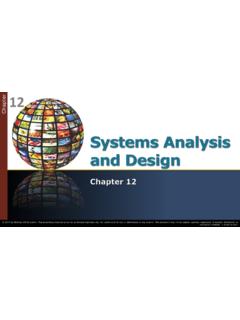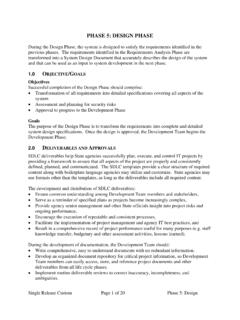Transcription of IT216 Systems Analysis and Design - Volgenau …
1 Copyright 2016 Vivian Motti. All rights reserved. Page 1 of 9 Information Sciences and Technology Course Syllabus IT216 Systems Analysis and Design Catalog Description Students survey and apply techniques in analyzing and modeling information Systems . Requirements are derived in various domains and abstracted at conceptual, logical, and physical levels. Process, data, and state modeling are applied through a project that follows a Systems development lifecycle. Object modeling is explored and contrasted. A user-centered Design approach is adopted. Prerequisites IT 214 and IT 102 or IT 206. The prerequisite course must be completed prior to, not concurrently with, this course. If you have questions about this policy, please contact the Instructor so that problems can be avoided later on (such as being dropped from the course). Rationale This course will cover the principals of information Systems including Analysis and Design .
2 Students will learn techniques in data requirements collection and Analysis along with methods to modeling data needs. Modeling of data will occur at the conceptual, logical, and physical levels along with an ability to compare and contrast the different approaches given their merits and limitations. Students will understand the importance and constraints imposed by the domain of the information system along with business rules that guide the Design . Functional dependencies and domain normalization will also be discussed as part of the requirements Analysis . Object-oriented information system modeling will be surveyed. User-centered Design techniques will be explored. Objectives Students will demonstrate the ability to extract, analyze, and organize end-user requirements. Included will be an ability to utilize process, data, and state modeling in a variety of domains. Students will also examine data-oriented and object-oriented system Design .
3 Upon successful completion of the course, students will be able to: o Develop a requirements document that details and models an information system Design . o Utilize data flow diagramming, entity relationship modeling, and state process modeling in user requirement Analysis . o Compare and contrast conceptual, logical, and physical data models. o Demonstrate an understanding of object and procedural modeling. IT 216 Systems Analysis and Design Syllabus Copyright 2016 Vivian Motti. All rights reserved. Page 2 of 9 o Recognize and incorporate user requirements, business rules and constraints into the Design of an information system . o Address functional dependencies in the normalization of a system . Textbook There is one required textbook for this course: system Analysis and Design , 9th Edition Kenneth E. Kendall, Rutgers University Jullie E. Kendall Pearson 2014 ISBN-10: 0133023443 ISBN-13: 978-0133023442 Faculty and Staff Instructor and Course Coordinator: Vivian Genaro Motti Faculty, IST Department Phone: 703-993-5868 Email: Administrative support: Fairfax campus Julija Shimkute , Room 5400 Phone: 703-993-3565 Science and Technology campus Vacant Bull Run Hall, Suite 102 Phone: 703-993-3565 IT 216 Systems Analysis and Design Syllabus Copyright 2016 Vivian Motti.
4 All rights reserved. Page 3 of 9 Grading Final averages are assigned a letter grade according to the following ranges: Percentage Grade Courses [97, ) A+ Passing [93, 97) A Passing [90, 93) A- Passing [87, 90) B+ Passing [83, 87) B Passing [80, 83) B- Passing [77, 80) C+ Passing [73, 77) C Passing [70, 73) C- Conditional Passing [60, 70) D Conditional Passing [0, 60) F Failing * Conditional Passing letter grades are considered passing for undergraduate courses. However, a Passing letter grade is required in the undergraduate Information Technology program for any course that is a prerequisite for other courses. The final grades will be determined based on the following components. Eventual modifications on the distribution below will be explicitly informed in class: Activity Distribution Checkpoints 10% Exercises 15% Examinations o Midterm o Final 20% 20% Final Project 25% Peer Evaluation 5% Participation 5% Note: If you are encountering difficulty in meeting course requirements, or should some dire circumstance arise, it is important you are proactive in contacting the Instructor prior to the due date.]]]]]]]]]]]
5 Potential problems can be minimized with an email. Delay in bringing your circumstances to the Instructor s attention will substantially decrease the likelihood of receiving a favorable outcome. IT 216 Systems Analysis and Design Syllabus Copyright 2016 Vivian Motti. All rights reserved. Page 4 of 9 The grading components are outlined in the following sections. Note that all assignments of a given component are given equal weight. Checkpoints Checkpoints are a crowd-sourced approach to learning and will be utilized throughout the semester to evaluate a student s mastery of the materials and learning outcomes. Students will create, evaluate, discuss, and answer questions related to the course modules. Involvement in the checkpoints will be anonymous to other students however the instructor will have access to the contributors in order to determine involvement.
6 You should prepare for checkpoints by understanding the material previously presented in the session module including any reading assigned before the checkpoint. Checkpoints serve to have students carefully think about topics presented in the course and potentially how they relate to the learning outcomes. As a reinforcement of the materials in the course, students will have the ability to consider misconceptions, ambiguity, and potential alternative interpretations of a topic area. Checkpoints also serve as a self-assessment point on understanding while requiring students to clarify their understanding of a topic area. Finally, students will be able to reinforce their knowledge of an area by reflecting on the contributions of other students in the course. This allows students to sharpen higher-order cognitive skills that will also prove helpful when applied to requirements analyses. As checkpoints are part of the flow of the modules and are a group activity, requests to complete checkpoint assessments at a different time will not be honored except in exceptional circumstances.
7 Exceptional circumstances include a documented medical excuse, a serious family emergency, or scheduled university-approved off-campus event. These must be arranged with the Instructor in advance. Exercises Exercises provide an opportunity for application of the topics presented in the course modules. Some exercises may be in session whereas others may be completed outside the session. Exercises are intended to be individual work unless otherwise noted. If an exercise is designated as being completed as a group, it will be the responsibility of the student to put together a group. If a group cannot be formed in a timely manner then it is the individual student s responsibility to complete all the group work of the exercise individually. Examinations The exams will cover material presented in the text and lecture and will be used to evaluate your mastery of terms, concepts, and application.
8 There will be a review period the session before each exam. You should prepare for the exams by understanding the material presented in the class session, notes, exercises, and the readings in the text. Exams will be a combination of short answer, fill in the blank, and multiple choice in addition to process, data, and state modeling. To complete these exams you will not be allowed to use your notes, text, web, etc. Exams are retained by the Department and are not returned to students, however grades are posted on Blackboard. IT 216 Systems Analysis and Design Syllabus Copyright 2016 Vivian Motti. All rights reserved. Page 5 of 9 Anticipated exam dates are shown on the Course Outline. As exam answers may be reviewed, requests to take exams at a different time will not be honored except in exceptional circumstances. Exceptional circumstances include a documented medical excuse, a serious family emergency, or scheduled university-approved off-campus event.
9 These must be arranged with the Instructor in advance. Final Project During the semester, there will be one project that you will complete. The project is an information system Design and as a reasonably large assignment will take several sessions to complete. Each student may be required to work in a group to complete the project and this will be determined later in the semester. As the project will be due near the end of the semester, late submissions will not be accepted. Participation Students are expected to complete any required preparatory work, attend each course session, and participate actively in lectures, discussions, and exercises. Active participation is essential in a course dealing with abstract concepts and data modeling. Participation should take the form of questions, feedback, Analysis , information, and examples all in support of the class's exploration of the topics, reading, and assignments.
10 As members of the academic community, all students are expected to participate regardless of their proficiency with the subject matter. It should be understood that the grade for participation may be subjective and competitive in nature. This means that there are no concrete rules for exactly what constitutes full participation. A well thought out contribution will always be more useful than discussions that stray significantly from the topic at hand. Final grades will be posted to Patriot Web, and will not be emailed or appear on Blackboard. A student with a hold on their academic account will be unable to access final grades until the Registrar has removed the hold. IT 216 Systems Analysis and Design Syllabus Copyright 2016 Vivian Motti. All rights reserved. Page 6 of 9 Course Outline Week Module Topic(s) Grade Component Due Reading Due 01 o Welcome to the Course o system , Roles and Development Methodologies o Chapter 1 02 o Project Management o Information Gathering o Checkpoint: 01 o Chapter 3 o Chapter 4 o Chapter 5 03 o Agile Modeling and Prototyping o Checkpoint: 02 o Chapter 6 04 o Data Flow Diagrams o Checkpoint: 03 o Chapter 7 05 o Object Oriented system Analysis & Design Using UML o Chapter 10 06 o Design Using UML (cont.)






